Chiangmai, Chiang Rai, The Golden Triangle Travel (Part I)
Filed under: Chiangmai Travel I
Chiangmai, Chiang Rai, The Golden Triangle Travel (Part I)
Thailand (Free Land) is dubbed “The Land of 65 Million Smiles”. It is well-known for its many tourist spots. And Chiang Mai is one of them.
Location of Chiang Mai Chiang Mai is in North Thailand and is about 750 km north of Bangkok. It is over 310
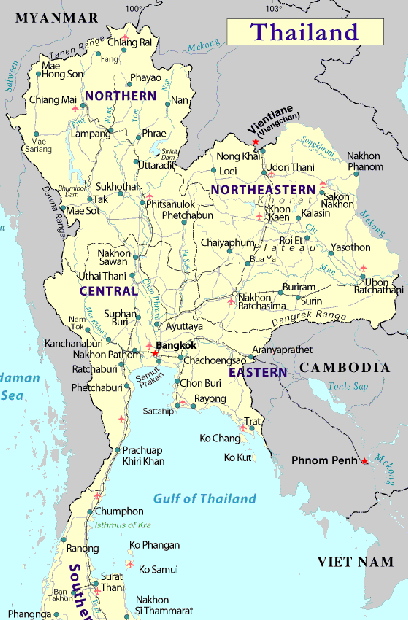
Map of Thailand
metres above sea-level and located in a large flat Slain surrounded by dense monsoon forest-covered mountains in the east , north and west. A river, Ping River, flows from north to south through the plain to join the Thailand’s longest river, Menam Chao Phraya.
Climate It has a Tropical Monsoon climate with the temperature ranges from 13 to 28 degrees C between mid-November and January and 17 to 36 degrees C between February and mid-November. The raining season starts from June to mid-November.
Population It is the second largest city in Thailand with a population of about 250,000. Most of the inhabitants are Thais and majority of them embrace Buddhism.
Hill-Tribes Chiang Mai also has several small hill-tribes living in the rural areas, such as the Karen (Kariang, Yang), Akha (Ekaw), Lisu (Lisaw), Lahu (Mussur), Yao (Mien) and Hmong (Meo). These hill-tribes are steeped in traditions and cultures. They live on subsistence agriculture like planting paddy, maize, fruits and vegetables.
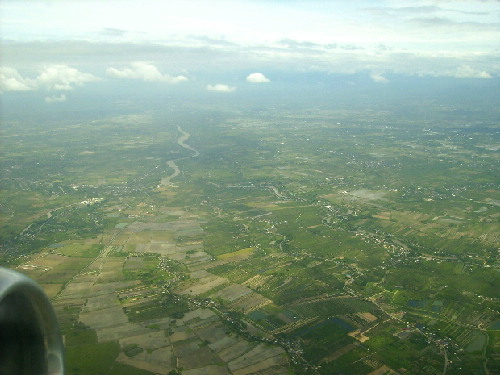
Chiang Mai in a plain
In spite of the rapid growth in the last 10 over years Chiang Mai is still a charming and quaint city. It is dubbed “The Rose of the North” and North Thailand is known as “The Kingdom of a Million Rice Fields”.
Tourism Chiang Mai is well linked to Bangkok by road, rail and air. Tourism is now a fast growing industry in Chiang Mai. Its charm, beauty, tranquility and rich culture attract hundreds of thousands of domestic and foreign tourists every year. Besides, the people are kind, friendly and hospitable. Tourism is an important industry to the local people as it provides them lots of jobs in hotels, transport, restaurants, cottage industries and recreational and entertainment activities.
History According to the Siamese history, Chiang Mai was established by King Mengrai in 1296. Later, in 1558, it
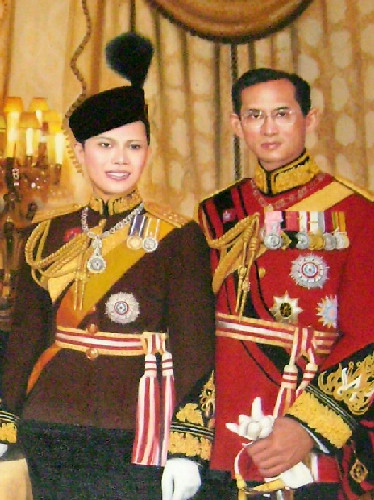
King and Queen of Thailand
was captured by a Burmese king, King Bayinnaung of Pegu,. Since then it was ruled by the Burmese for about a quarter century. Then in 1799 it was recaptured by a Siamese prince, Prince Kawila.
The present King of Thailand is King Bhumibol. He was born on 5th. Dec 1927 and acceded to the throne on 9th. June 1946. He is fondly loved and respected by his subjects because of his compassion, warmth and commitment to his country’s progress. He is the world’s longest reigning, living monarch.
New and Old City The city is divided into two parts by the Ping River. To the west of the river is the old part of the city whereas to the east the modern one. The former offers more interesting tourist attractions.
In the old part of the city there is a rectangular moat (1.8 km x 2 km) which surrounds a wall made of bricks and earth. The wall was built to protect the
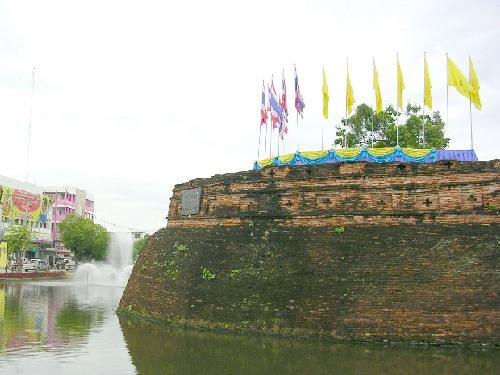
A moat and wall in the Chiang Mai old city
royal city during the reign of King Mengrai. This part of the city is more than 700 years old.
Buddhist Temples Buddhist temples can be seen all over the city and also in the outskirts. It claims to have more than 300 temples which the Thais called them wats. A large number of them are restored and used for religious purposes. Saffron-robed monks are a common sight in the city.
Most of these temples have common features. They have a consecrated ceremonial hall which houses a large Buddha figure and other artifacts. The walls of the hall are beautifully decorated with murals depicting scenes of Buddha’s life. Near the hall is a monks’ living quarter and a general purpose
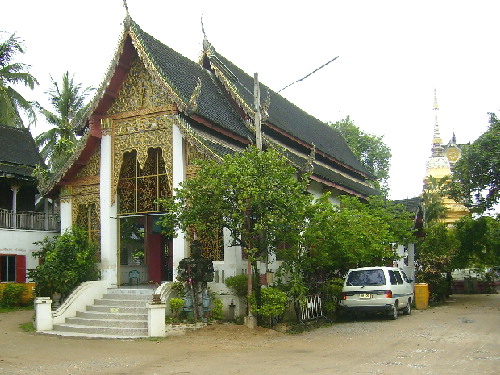
A Siamese temple
hall. Besides, a temple has a tall tower (chedi or stupa) which is either in the shape of a bell or stepped style (prasat style). Some temples have a school in their compound.
Buddhism is based on the teachings of Siddhartha Gautama who lived in North India in the 6th. Century B.C. (Before Christ). The religion spread to Thailand via the Khmer Empire and the Silk Route from China.
Temples play an important role in the ritual and social life of the Thais. It is a normal practice for every Thai male to take up monkhood at least once in his lifetime.
My wife, our big son and I wanted to enjoy the sights and sounds of Chiang
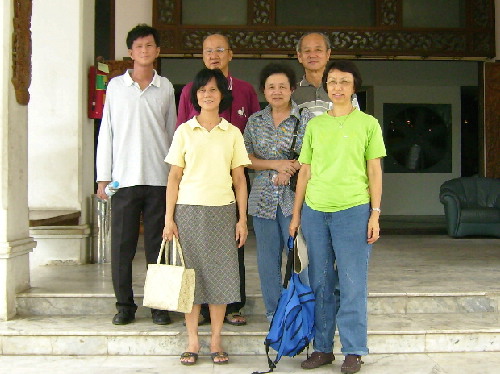
Writer and his tour group. (The writer is the first person from the right in the back row)
Mai very much. So, on 4 July 2006, we joined three of our friends from our hometown and flew together on a low budget plane, Air Asia, from Kuala Lumpur straight to Chiang Mai. The journey took less than three hours.
The Travel Itinerary The following is the itinerary of our unforgettable Chiang Mai experience:
Day 1 Travel to Chiang Mai City
Cottage Industries I
Cottage Industries II
Day 2 Travel to Chiang Rai
Hill-Tribes of Northern Thailand I
Hill-Tribes of Northern Thailand II
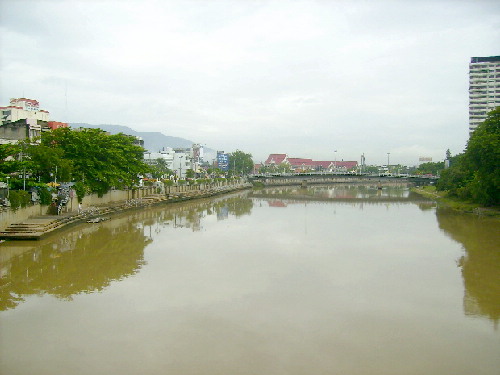
Ping River in Chiang Mai
The Golden Triangle
Mae Sai (BorderTown)
Day 3 Maesa Elephant Camp
Mae Ram Orchid Farm
Mae Sa Snake Farm
The Monkey Centre
Wat Phratat Doi Suthep
Chiang Mai Arts & Cultural Centre (Museum)
Chiang Mai Night Bazaar
Day 4 Warorot Market
Departure to Malaysia
Day 1 Tuesday 4 July 2006 Travel to Chiang Mai City
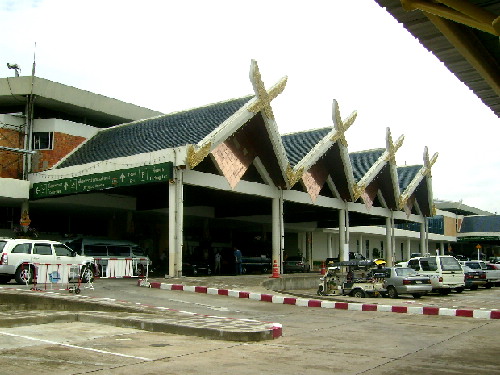
Chiang Mai Airport Terminal
Upon arrival at the Chiang Mai airport before noon, we took a ‘minibus’ to the downtown. In the city we saw large pictures of the Thai king, King Bhumibol, and Thai flags flying everywhere. The whole nation was celebrating the 60th. anniversary of their king’s accession to the throne.
Lai-Thai Guest House We checked in at a hotel known as Lai-Thai Guest House which we had booked earlier through Internet. It is at 111/4-5, Kotchasarn Road, Chiang Mai 50100 (www.laithai.com). It is a three-storey semi-wooden building that is in a U-shape and has a clean swimming pool in the centre. The building is built in Siamese architechural style.
‘Tuk-Tuks’ After lunch, six of us hailed two ‘tuk-tuks’ to bring us to see
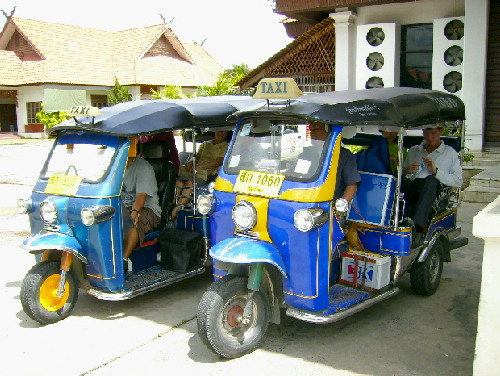
“Tuk-Tuks”- A cheap popular mode of transport in Chiang Mai streets
some famous cottage industries located along Chiang Mai-Sankampaeng Road. Our two friendly ‘tuk-tuk’ drivers introduced themselves as Yau and Pantip.
A ‘tuk-tuk’ is a small three-wheeled vehicle which runs on petrol and can carry three passengers at the back. The only problem with this type of vehicle is that its roof is too low.
Chiang Mai Cottage Industries
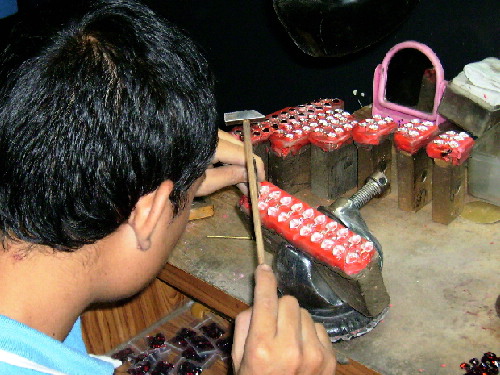
A jewel maker fixing a gem in a ring at International Fine Creation Co. Ltd.
Our ‘tuk-tuks’ we hired brought us to the Chiang Mai-Sankampaeng Road to visit some cottage industries. This road is also known as “Handicrafts Highway” as there are countless cottage industries of handicrafts on both sides of the road such as silverware, copperware, lacquerware, woodcarving, parasol making, leather goods and many more.
Silver Factory The first industry we visited was P-Collection Factory which makes all kinds of silverware. In the factory, artisans can be seen busy making silver articles like jewellery and figurines.
Jewellery Factory International Fine Creation Co. Ltd. was the next factory
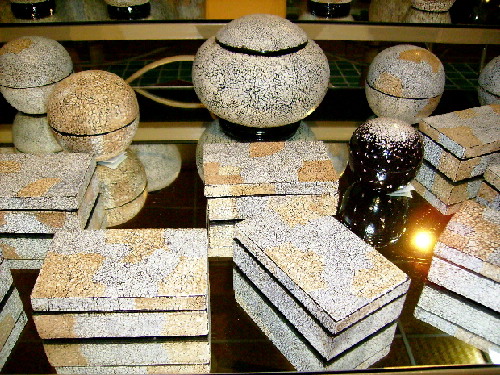
Egg-Shell Covered Containers
we went to. It makes and sells jewellery with precious stones which are beautifully cut, like sapphire (pink, blue), emerald (green). topaz (orange), opal (mixed green and blue), garnet (red), diamond, ruby, amethyst and many more.
Leather Factory S.K. Leather Co. Ltd. produces goods made of skins of snakes, crocodiles, deer and cows such as bags, handbags, belts, shoes, wallets and clothes. It exports most of its goods.
Lacquerware Factory Then we went to another factory known as
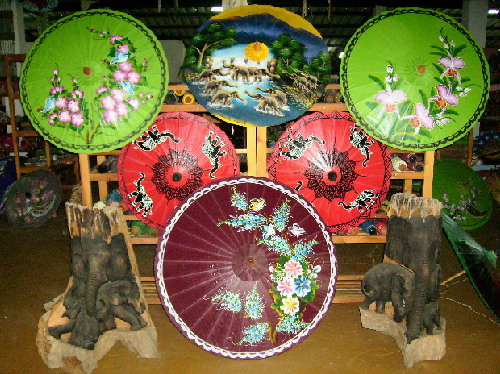
Beautifully-Painted Umbrellas
Lantong Factory Ltd. where lacquerware is made. Here wooden objects are sculptured, painted and finally lacquered so that they look shinny. At that factory, I watched a worker painstakingly gluing small pieces of egg shell on to a seven-sided black board and then pressed them into smaller pieces giving the board an artistic pattern. That was an interesting and unusual piece of art.
Parasol Factory Sankampaeng Umbrella & Handicraft Industry produces silk, cotton and paper umbrellas of different sizes. The umbrellas are beautifully painted by talented local artists. They usually paint flowers and elephants on the umbrellas.
Woodcarving Factory Chiang Mai Sudaluck produces teak and
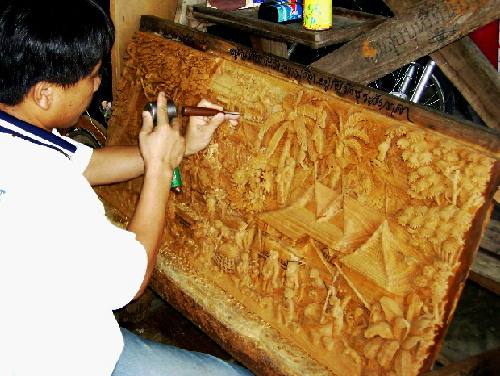
A wood-carver painstakingly carving a 3 D-picture
rosewood furniture with beautiful carvings. Besides, its skilful and artistic workers are able to produce 3-dimensional pictures of Siamese villages on rosewood and wooden sculptures. Carving a 150 cm x 50 cm three-dimensional picture of a village usually takes an expert-carver two months to complete.
Carpet Factory Heritage International Ltd. sells beautifully designed carpets for use and carpets with semi-precious stones sown on them for wall decoration. Besides, it imports bronze antiques from India for sale.
Jade Factory Siam Gifts House of Jade was the last factory we visited. It
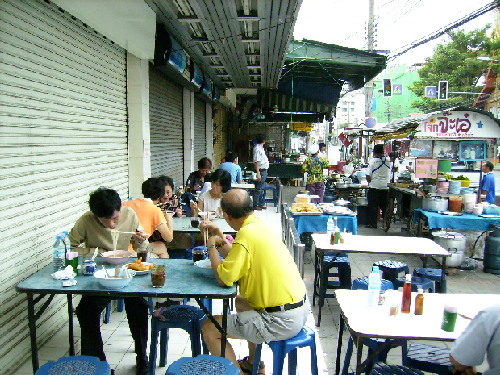
A Siamese Roadside Noodle-stall
sells a variety of products using jades of all kinds of colours, like jewellery, figurines and large and small objects.
Day 2 : Wednesday 5 July 2006 Travel to Chiang Rai
Our Coach Driver and Guide At about 7 a.m. a coach we had hired earlier came to our hotel. The coach driver introduced himself as Mr. Nom and the tour guide, a young fresh university Thai graduate, as Mr. Hacks. As we had not taken our breakfast, our kind driver brought us to a popular roadside noodle-stall not far from the hotel. We sat tha tables on the five-
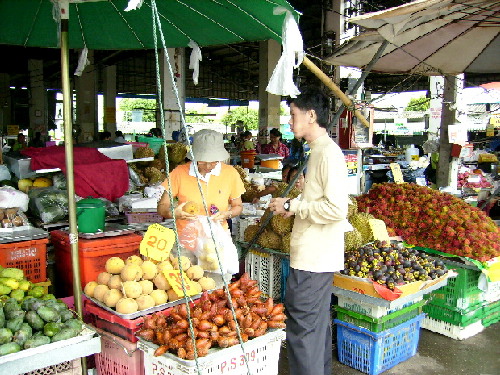
A fruit stall at Bandu Municipality Market, Chiang Rai
foot way and soon we were served with hot Siamese noodle soup. After the delicious meal, we began our long journey to the north to Chiang Rai.
Chiang Rai On the way, we passed through a scenic mountainous region. When we reached Chiang Rai we stopped at a market known as Bandu Municipality Market, Fresh local vegetables and fruits were bountiful there. We bought big, juicy and sweet lychees, durians, rambutans and cut pineapples. Besides, we bought some local snacks to munch while travelling in the coach.
A Baby Elephant At the market we were surprised to see a baby elephant. It was following its owner who was selling some snacks. Kind
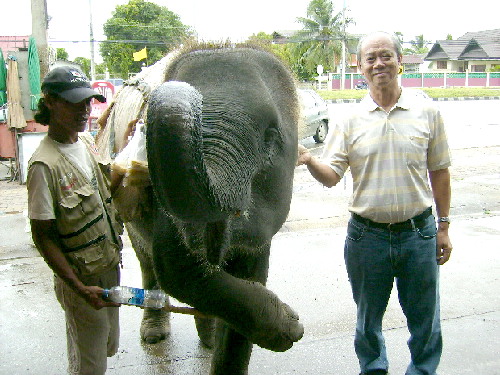
Writer posing with a baby elephant which made a curtsey at the Bandu Municipality, Chiang Rai
vegetable and fruit sellers who found the animal so cute and lovable gave it some of their produce. Foreign tourists and I asked the friendly owner for permission to take a photograph with the tame elephant. We were amused when it curtsied.
Union of Hill-Tribe Villages Then we moved on again. The next stop was a well-known place, Union of Hill-Tribe Villages, which is 12 km from Chiang Rai. At this place one will see five types of hill-tribes in their traditional costumes, namely Akha, Yao, Mussur, Palong and Karen. They stay at their mini-villages which are at different spots but near to each other. They are there during tourists’ visiting hours only as the place is just a showcase of Thailand’s different hill-tribes.
Hill-Tribes in Northern Thailand In the olden days, the hill-tribes
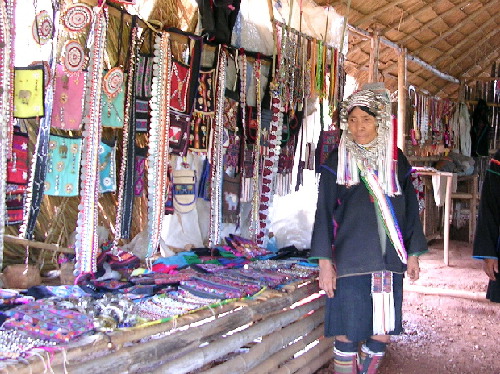
An Akha lady selling handmade articles
migrated from southern China to Myanmar, Thailand, Laos and Vietnam.
Now, there are six major hill-tribes in Northern Thailand belonging to the Thai national minorities, namely Karen (Kariang, Yang), Akha (Ekaw), Lisu (Lisaw), Lahu (Mussur), Yao (Mien) and Hmong (Meo).
These hill-tribes are steeped in traditional cultures and live on subsistence farming. They use simple tools like hoes to cultivate hill paddy and plant cash crops, such as maize, fruits and vegetables on a small-scale. They also raise domestic animals like fowl, goat and buffalos.
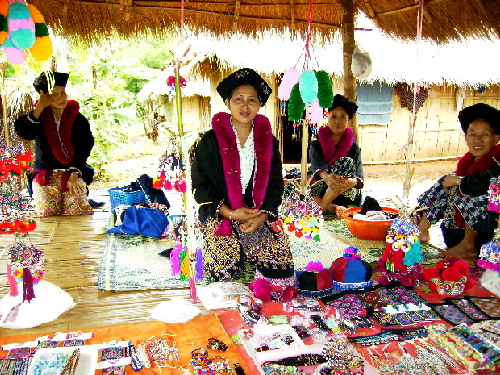
Yao ladies selling handmade articles
Most of these tribes live in poverty. Their wooden houses are small and the roofs are made of dry large leaves or fronds of palm trees. They have bare necessities inside their houses.
Each tribe has its own distinctive culture, religion, language, art and traditional costumes.
The hill-tribes believe in territorial spirits for forests and fields, tutelary spirits for houses and towns, and ancestral spirits.
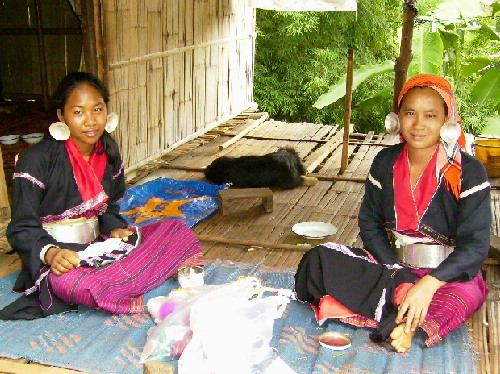
Palong ladies
These tribes are good at making handicrafts. They sell them in Chiang Mai and other towns to earn extra income.
Union of Hill-Tribe Villages Located 12 km from Chiang Rai, the Union of Hill-Tribe Villages is a showcase of five hill-tribes, namely Akha, Yao, Mussur, Palong and Karen.
Before we entered the villages, a man at the main entrance asked us to look at a dirty, old map and told us the route we had to take to visit the five hill-tribes. As it had rained earlier the ground was wet, soft and slippery. So, he
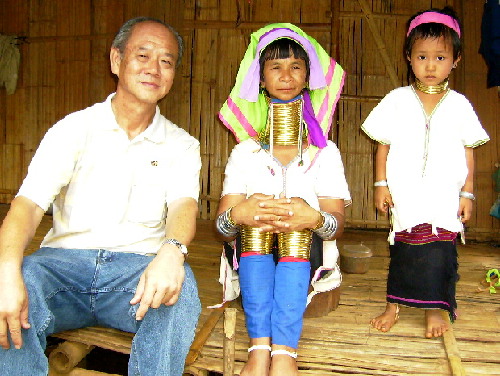
Writer sitting with the Karens with brass coils
asked us to take along a long stick each.
Akha Village The first village we came across was the Akha village where we were greeted by a few young and old ladies in their traditional clothes. They were sitting on raised bamboo platforms in front of their houses. They were wearing black headgears covered with silver coins. We felt frustrated as we could not converse with them in their language or Thai. All we could do was to smile, say “Hello” and wave our hands to mean “Goodbye”. Then we walked to a larger house where a group of Akha ladies entertained us with their simple traditional musical instruments.
Yao Village The next village we visited was the Yao’s. The Yao
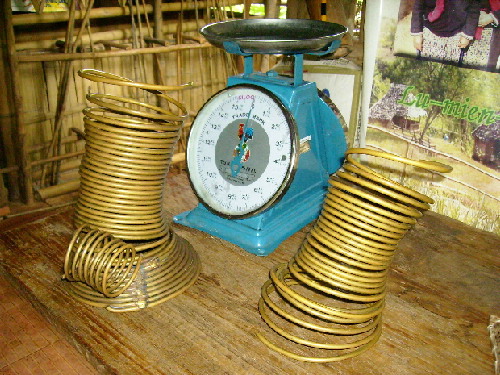
Use a weighing machine to find out the weight of a Karen brass coil
ladies looked well-dressed in their traditional costumes. They wore black turban-like headgears. When they saw us, they greeted us with a big smile. We were surprised that two of them could talk to us in Chinese. After a short conversation with them, we had a good look at their handmade purses. jewellery, trinkets, etc.
Palong Village Then we visited the Palong hill-tribe. We noticed the Palong people were wearing simple black clothing and some ladies were wearing simple coloured head-scarves. They entertained us with a lively traditional dance. Their children joined them too.
Karen Village The last hill-tribe we visited was the well-known Karen. We were fascinated and amazed to see only female children and women
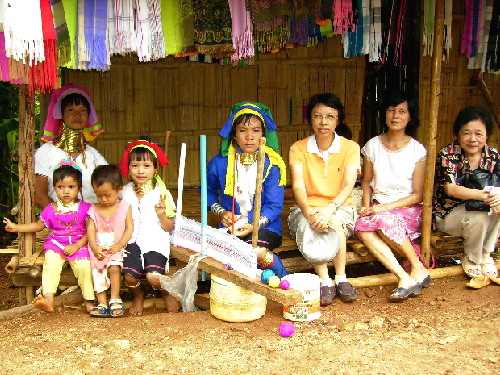
A large Karen “family”
wearing shiny brass coils round their necks. They were very friendly and loved to take photos with us.
Female Karens are the only people in the world having very long necks. They start wearing coils round their necks when they are a few years old. As they grow older more turnings are added to their coils. Some say they wear the coils to prevent tigers from biting their necks and others think they wear them for beauty hoping to get a life-long partner easily.
I left the Karen hill-tribe with a big question in my, i.e. “How do they eat, drink, bathe, sleep and get up from their beds with the heavy metallic coils round their necks?”. A large neck coil may weigh about 5 kilograms!
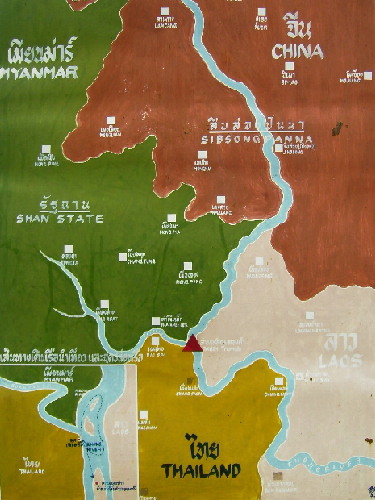
Map showing the location of the Golden Triangle
After visiting the hill-tribes, we went to a place where we sprayed water on the soles of our shoes to get rid of the mud which we had collected while walking in the hill-tribe villages. Soon we left the place and continued our journey to the well-known Golden Triangle in the north.
The Golden Triangle The Golden Triangle was actually a notorious region for the harmful opium trade. It covered a large area of 350, 000 sq. km. including the northern parts of Thailand, Laos and Vietnam, and eastern part of Myanmar. As the governments of the four countries knew that drug addiction would ruin their people’s lives and cripple their economies, they constantly cracked down on drug barons and encouraged their people especially the hill-tribes to plant cash crops instead of opium poppies. Now, they have successfully eradicated poppy-growing
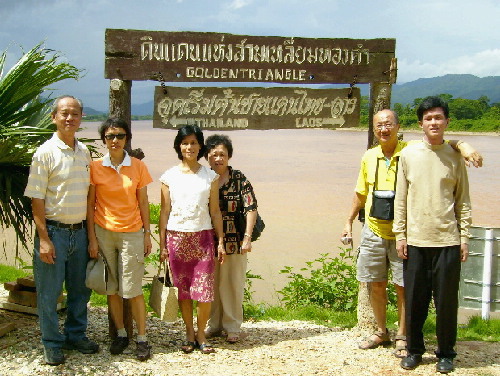
Writer and his tour members at the Golden Triangle
in many parts of their countries. They are always on the look out for illegal planting of the poppies, especially in the jungle areas.
Now the Golden Triangle is a small area around the confluence where River Mekong (or Mae Khong- 4,184 km long) and River Ruak meet. These two rivers form the common border for Thailand, Myanmar and Laos. The Golden Triangle is now a popular tourist attraction that reminds visitors of the past busy and lucrative opium trade there.
Sop Ruak A small old Thai town known as Sop Ruak exists in the Golden
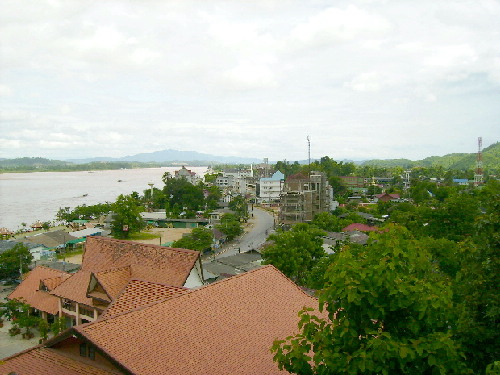
Sop Ruak Town in the background and Mekong River on the left
Triangle and is 9 km north of Chiang Saen. It is located by the Mekong River. Small restaurants, souvenir shops and other types of shops line the roads of the town.
On arrival at the Golden Triangle we noticed that the place has a picturesque view of the two wide rivers, the lush green forest-covered mountains in the distance, the quaint Sop Ruak town and the old and new temples.
An Open Air Temple There is a beautiful open air temple at the confluence where a huge golden statue of Buddha sits cross-legged on its large altar. It is about 8 metres high. At the back of this statue is a smaller white statue of a
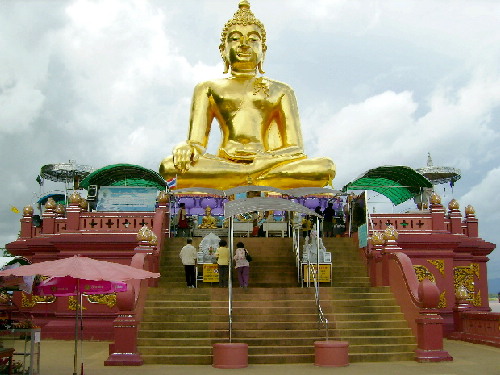
A Large Golden Statue of Buddha at the Golden Triangle
Chinese version of Buddha, “Tuah Peh Kong”. In front of the golden Buddha are three smaller golden statues of Buddha and a large statue of a black elephant carrying Buddha’s relics. Further down the Mekong River bank are six golden columns with beautiful and intricate Siamese designs which I think are monuments to the great Siamese kings. On the Myanmar river bank in the distance are some red-roofed buildings which are known as Paradise Resort. It has a casino to attract foreign tourists.
It is a frustration for a foreign tourist not to know the names of the temples, the structures and the statues at the confluence as all the writings there are in Thai. I hope the Thai government will translate them especially in English for foreigners.
Wat Phrathat Pukhao On top of a small hill near the confluence is a small, old
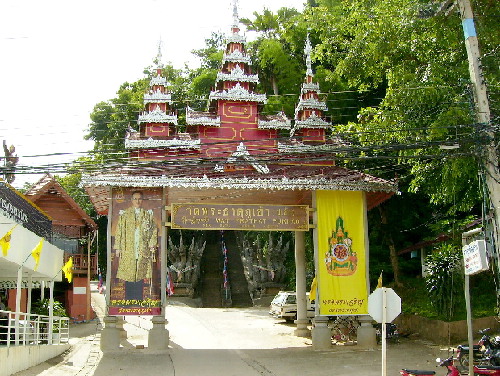
Wat Phratat Pukhao Arch
and simple temple which is over 1000 years old. It is known as Wat Phrathat Pukhao. To go up to the temple, I walked up a flight of 104 steps alone. These steps are lined with two long Siamese legendary grey dragons each with five heads. Each head has a long crooked horn projecting from its forehead.
When I reached the top, I realized I was the only person around. Fearlessly, I looked around and walked to the doorstep of the temple. I looked inside and saw a large statue of Buddha looking down at me. After taking a few photos at the temple, I walked to a vantage point nearby. From that point I could see a scenic panoramic view of Sop Ruak town, the wide Mekong River and the
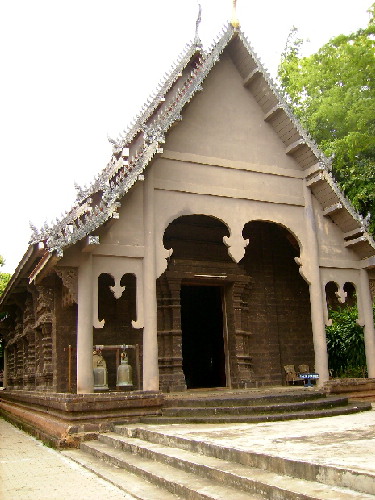
Wat Phratat Pukhao (A temple of over 1,000 years old)
lush green mountains in Laos. Then I went down the hill to join my tour group.
Hall of Opium Museum Owing to time constraint, we did not visit a museum at the Golden Triangle. It is known as Hall of Opium where one can gain an insight into the history of opium trade there and harmful effects of opium. The museum provides photographs, films and videos about opium and other types of dangerous drugs from other countries. It should be a worthwhile visit there if one has some time to spare.
Our next destination was a Thai border town known as Mae Sai which is 28 km by road from the Golden Triangle.
Mae Sai (A Border Town) Mae Sai is the northern-most town in North
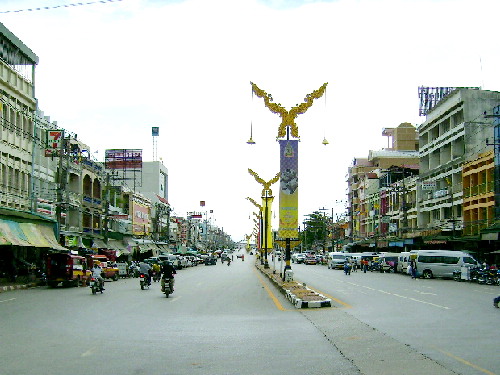
Mae Sai, aThai border town
Thailand. It is a small town near the Myanmar border. It has a large arcade where lots of stalls are selling a myriad of things ranging from accessories and clothes to watches and electronic goods. Near the place is a brightly and heavily-decorated temple which houses a large statue of Buddha. Besides, it has colourful murals inside depicting the Buddha’s life.
Mae Sai has an immigration checkpoint at the border between Thailand and Myanmar. To cross over the border to a small town known as Tha Kwee Lek in Myanmar, one may pay 300 Thai baht to a Thai motorcyclist who will bring one
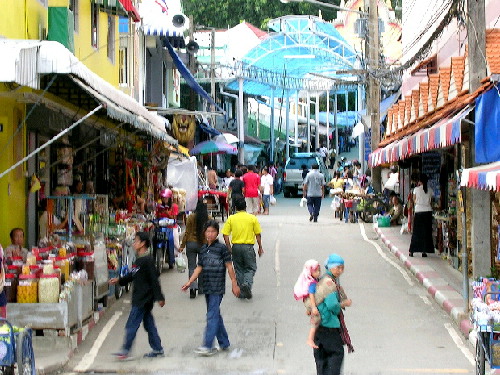
Mae Sai Shopping Arcade
over there. One may extend one’s Thai visa when one comes back to Mae Sai from Tha Kwee Lek.
At about 4 p.m. I saw many Myanmar vendors pushing their carts with unsold goods to the the immigration checkpoint. They were going back to their country after a day’s business at Mae Sai Town.
Chiang Rai Hot Spring After spending an hour at Mae Sai, we headed back to Chiang Mai City. On the way, we stopped at Chiang Rai to see natural hot spring water in three wells. The steam coming out of the wells has a little bit of sulfur smell. As the temperature of the water is 90 degrees C, local
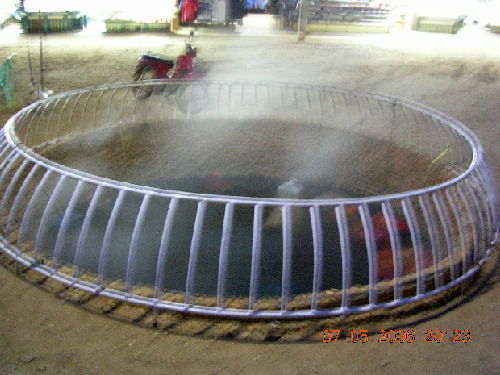
A Hot Spring Well at Chiang Rai
people immerse bags of sweet-potatoes and corns in the hot water for half a day to get them cooked. Then they take them out and either sell or bring them home to feed their families.
One can buy some eggs from lady-vendors near a well, borrow their bags for the eggs and slowly lower them into the well using strings attached to the bags. If one waits for a few minutes, one will get to eat the hard-boiled eggs.
Many stalls selling souvenirs, jewelleries, accessories, handicrafts, clothes, etc. are found near the wells.
Dinner at Anusarn Market At 9 p.m. we finally reached Chiang Mai. We had late dinner at Anusarn Market where there are many open-air restaurants. After dinner we visited a few stalls along Chan Klan Road. An hour later we went back to our hotel.
